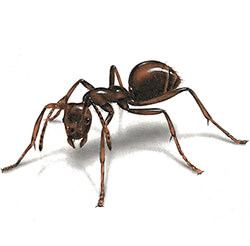Identification
- Size From 1.5 mm to 13 mm
- Colour Black, dark brown, red, or tan
- Description Ants' bodies are divided in three distinct parts: head, thorax and abdomen. The thorax is joined to the abdomen by nodes. All ants have six legs, but only reproductive ants have wings
- Notes Canada has over 100 species of ants, some of which are structure-damaging species and can take residence in or around your home.

Types of ants in Canada
Common structure-infesting ant species found in Canada include the black carpenter ant, pavement ant, pharaoh ant, odorous house ant, Argentine ant, and thief ant. Most of the ant problems in Canadian homes are caused by carpenter ants, pavement ants, and pharaoh ants. Of all ant species, the black carpenter ant is the largest in size and the most common to cause structural damage. Pavement ants depending on location of nests are more of a nuisance, especially if nesting indoors. The pharaoh ant is another indoor nuisance pest, often attracted to foods high in protein and sugar.
Ants can be difficult to remove once they establish a colony. Managing and controlling infestations is necessary if ants are frequently seen in your home or there are signs of a nearby nest. Before controlling an ant problem, it is important to know what species of ant you are dealing with. Having basic knowledge on the appearance, behaviour, nesting habits, and type of problems ants cause can help identify the ant species in order to use proper control methods.
Appearance and identification
Ants are generally easy to recognise; their colour is usually black, dark brown, red, or tan in colour. Depending on the species, their size can range from 1.5 mm to 13 mm in length. Like all insects, the body of an ant is divided in three distinct parts: head, thorax and abdomen. The thorax is joined to the abdomen by constricted petioles, also known as nodes. Depending on the species, some ants have a single node and others have two nodes. All ants have three pairs of legs used for walking, and they do not have wings, except for the reproductive swarmers, which have two pairs of functional wings used for mating and dispersal flights.
Habitat, Diet, Lifecycle
Habitat
Ants are social insects that live in colonies with populations often reaching hundreds of thousands. Most ant colonies build nests in soil. Some species, like the carpenter ant, tunnel into wood to create nesting chambers. A typical ant colony consists of three distinct social castes: the queen, drones, and workers. Most colonies have one queen and a vast number of workers, but the colonies of some species can have multiple queens. The queen’s function is to lay eggs and control activities of the nest via pheromone communication. The most likely to be seen outside the nest during non-swarming season are the workers. The workers forage for food to carry back to the colony. Foraging often brings ants into the home, because they are attracted to nearly any food humans may leave out. Sugary foods, meats, and grease are particularly attractive to ants.
Diet
Ants are social insects that live in colonies with populations often reaching hundreds of thousands. Most ant colonies build nests in soil. Some species, like the carpenter ant, tunnel into wood to create nesting chambers. A typical ant colony consists of three distinct social castes: the queen, drones, and workers. Most colonies have one queen and a vast number of workers, but the colonies of some species can have multiple queens. The queen’s function is to lay eggs and control activities of the nest via pheromone communication. The most likely to be seen outside the nest during non-swarming season are the workers. The workers forage for food to carry back to the colony. Foraging often brings ants into the home, because they are attracted to nearly any food humans may leave out. Sugary foods, meats, and grease are particularly attractive to ants.
Lifecycle
Ants begin life as eggs, laid by a queen ant when she mates with a male ant. The oval, white, transparent eggs are tiny – only 0.5 mm across – so are very difficult to spot.
After one or two weeks, these eggs hatch into larvae. Adult ants regurgitate the food they have already eaten to feed these extremely hungry grubs.
The larvae then shed their skin to become pupae, which look like white adult ants but with their legs and antennae folded up against their body.
Over time, these pupae get darker in colour, eventually becoming adult ants. These adult ants are either new queens, female workers, or male drones.
While the wingless female workers set about foraging for food and feeding the larvae yet to hatch, new queens and male drones have wings and fly away in a nuptial flight to mate.
After mating, they lose their wings and the male drone quickly dies. The queen builds a new nest, and begins laying eggs, controlling the gender of her eggs to match the colony’s needs.
Ant queens can keep laying these eggs for decades, living for up to 30 years, while workers live up to three years and drones only live for a few weeks.
Do ants bite
The mouth parts of ants have adapted for biting and chewing solid food. Some species have jaws strong enough to bite through human skin, but most cannot. Ant species such as black carpenter ants can bite if provoked. Some ant species including European Fire ants sting and inject formic acid into the wound, hence a burning sensation at the site of the bite. The majority of Canadian ant species rarely inflict bites on humans.
Ants with wings
Ant colonies feature a hierarchical social structure in which thousands of sterile female workers maintain the nest, forage for food, care for larvae, and protect one or more queens, whose sole responsibility is to ensure the continued survival of the colony by laying eggs. Most colonies form when the new reproductive queens leave their old nest, mate with a male, and deposit their eggs at the site of the new colony. New reproductive queens and males are characterized their wings, which worker ants lack. In a ritual known as a nuptial flight the winged ants, also known as alates, depart from existing colonies when prompted by the weather, fly to a new location, and mate. The alates mate in swarms either aerially or terrestrially. The newly mated queens then fly off to locate a nesting site, detach their wings, and lay eggs. Winged males, on the other hand, die after completing the nuptial flight as they exist solely to mate with the queen. The swarming presence of winged ants indoors, especially during winter, strongly indicates a nearby colony.
Problems caused by ants
Ants are unsightly and a nuisance when found inside a home. A few species such as pharaoh ants have been implicated in disease transmission, especially in hospital and long-term care facilities. Outdoor nesting habits can damage lawns and gardens, as well. When dwelling indoors, ants may cause damage to the structure by chewing wood, insulation, and electrical cables during nest building. Select species of ants are capable of inflicting painful stings. Some individuals may develop inflamed skin at sting sites and experience cramps and headaches as reactions to ant venom.
Infestation - ants in the home
Because pest species of ants frequently establish colonies in populated areas, the insects often invade the homes of Canadian residents.
Attracted by the presence of food, foraging ants enter houses to scavenge for crumbs, oil or grease spills, sugar, and edible items regularly found in kitchen pantries and easily contaminate food items.
Ants gain entry to buildings through cracks in the walls or foundation, as well as through gaps or other small openings that often appear where moulding or plumbing connect with the structure.
Large numbers of ants can successfully invade homes by detecting and following an invisible trail produced by scouts sent previously by the colony to search for food.
Why do I have ants
Canada has more than 100 species of ants, including the black carpenter ant, pavement ant, pharaoh ant, odorous house ant, Argentine ant, and thief ant.
Foraging ants are attracted by food and enter homes to scavenge for crumbs, oil or grease spills, sugar, and other edible items.
Ants gain entry to buildings through cracks in the walls or foundations, or through other gaps and small openings that often appear where moulding or plumbing connect with the structure.
Large numbers of ants can successfully invade homes by detecting and following an invisible trail produced by scouts sent previously by the colony to search for food.
How can I prevent ants invading
Keep your home clean and sanitary, store food in tightly-sealed containers, clean up crumbs and spills promptly, sweep the floor regularly, rinse food containers before recycling, keep the structure well maintained, repair all cracks in walls and foundations, keep doors, windows, and entry points sealed.
How worried should I be about ants
Ants are unsightly and a nuisance that will contaminate your food. A few species such as pharaoh ants can also spread disease, especially in hospital and long-term care facilities.
If the ants nest outside, they can damage lawns and gardens. If inside, ants can cause damage to the structure by chewing wood, insulation, and electrical cables during nest building.
Some species of ants inflict painful stings, with the ant venom causing some people to develop inflamed skin and experience cramps and headaches.
Some ant colonies can grow exponentially quickly, making them even more difficult to eradicate. To stop this ant invasion in its tracks, you need a professional pest control service.
Types of Ants
100% Satisfaction or Money Back Guarantee
Resolving your pest problem is our #1 priority. If re-treatment is required, we'll provide immediate services at no extra cost. If your expectations are not met, we guarantee a full refund of your service payment.
Remove pests from your home, and stop them from coming back
We work hard to listen, understand and assess your unique situation. Request a free, no-obligation estimate today for a customized pest program that fits your needs.
Request a Free Home EstimateRequest a Free Business Consultation

